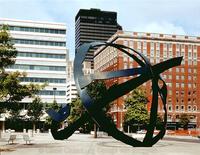Claes Oldenburg (b. 1929, Stockholm) grew up in Chicago and attended Yale University (1946-50) before settling permanently in New York City in 1956.
Oldenburg began a series of sewn and fabricated versions of ordinary household objects, later visualized in fantastic scale as “Proposed Colossal Monuments” for urban settings all over the world. In 1976, a 45-foot-tall sculpture in the form of a Clothespin was realized in downtown Philadelphia, the first such work in a ‘feasible’ scale.
Claes Oldenburg and Coosje van Bruggen began their artistic collaboration with the Trowel I, sited in ~ the Netherlands. Since that time, they have made over forty Large-Scale Projects in response to commissions by various cities, towns, and museums around the world.
Ordinary objects are the starting points for independent sculptures on a monumental scale, which create a dynamic interchange with their surroundings and redefine the relation between art and architecture.
“Monolithic” does describe many of these works — including Batcolumn, installed in front of Chicago’s Social Security Administration Building; and Clothespin, located in Centre Square in Philadelphia. They went on to build giant pool balls, a Crusoe umbrella, a flashlight, split button, hats, a garden hose, and a stake that could be used to used to tether giant horses that pierces two floor of the Dallas Museum of Art. They have build a spoonbridge with a cherry perched on it, a monument to the last horse, binoculars that are part of a building, and a bicycle that is so buried that you only see the small parts of the wheel, peddle, seat and handlebar rising above ground.
Critics recognized that the couple projects Pop Art themes forward, transforming art known for transience into very permanent works. In the process, Oldenburg and van Bruggen have freed Pop art from gallery walls and delivered it to the masses.

